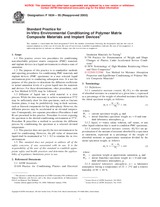Wir benötigen Ihre Einwilligung zur Verwendung der einzelnen Daten, damit Sie unter anderem Informationen zu Ihren Interessen einsehen können. Klicken Sie auf "OK", um Ihre Zustimmung zu erteilen.
ASTM F1634-95(2000)
Standard Practice for In-Vitro Environmental Conditioning of Polymer Matrix Composite Materials and Implant Devices
Automatische name übersetzung:
Standard Praxis für die In-Vitro Umweltanlagefür Polymermatrix -Verbundmaterialien und Implantatvorrichtungen
NORM herausgegeben am 1.1.2000
Informationen über die Norm:
Bezeichnung normen: ASTM F1634-95(2000)
Anmerkung: UNGÜLTIG
Ausgabedatum normen: 1.1.2000
SKU: NS-50972
Zahl der Seiten: 5
Gewicht ca.: 15 g (0.03 Pfund)
Land: Amerikanische technische Norm
Kategorie: Technische Normen ASTM
Die Annotation des Normtextes ASTM F1634-95(2000) :
Keywords:
accelerated conditioning, composite, diffusion, environmental conditioning, fiber, implant devices, moisture absorption, polymer, ICS Number Code 11.040.40 (Implants for surgery, prothetics and orthotics)
Ergänzende Informationen
| Significance and Use | ||||||||
|
The conditioning procedures covered in this practice provide methods for saturating PMC specimens in a liquid environment prior to conducting other tests for property evaluation. The conditioning may affect geometric and dimensional changes in specimens. In some severe cases, chemical changes may occur in the fiber, polymer and fiber-polymer interphase and interface. Caution must be taken if Procedure B (10.2, Procedure B—Accelerated Moisture Saturation at Elevated Temperature) is followed to condition PMC specimens at an elevated temperature. Physical and chemical reactions in materials are normally temperature dependent. An increase in experimental temperature may accelerate a desirable moisture diffusion process. However, elevated temperatures above 37°C may also cause undesirable reactions that do not represent appropriate responses of materials at 37°C. Consequently, a pilot study is recommended in Procedure B to determine if a selected elevated temperature can be used for accelerated conditioning. If the properties of materials are determined to be irreversibly affected by this pilot study at the selected elevated temperature, then either an appropriate lower elevated temperature should be determined by repeating the pilot study, or Procedure B should not be used. |
||||||||
| 1. Scope | ||||||||
|
1.1 This practice covers two procedures for conditioning non-absorbable polymer matrix composite (PMC) materials and implant devices in a liquid environment to obtain a state of saturation. 1.2 The purpose of this practice is to standardize methods and reporting procedures for conditioning PMC materials and implant devices (PMC specimens) in a user selected liquid environment prior to conducting subsequent tests. It is not the purpose of this practice to determine the diffusion coefficients or actual saturation levels of a given liquid into the materials and devices. For these determinations, other procedures, such as Test Method D 5229, may be followed. 1.3 Diffusion of liquid into a solid material is a slow process. While the time necessary to achieve saturation at 37°C may be sufficiently short for thin specimens, such as fracture fixation plates, it may be prohibitively long in thick sections, such as femoral components for hip arthroplasty. However, the diffusion process may be accelerated at an elevated temperature. Consequently, two separate procedures (Procedures A and B) are presented in this practice. Procedure A covers exposing the specimen to the desired conditioning environment at 37°C. Procedure B prescribes a method to accelerate the diffusion process by conditioning the specimen at a selected elevated temperature. 1.4 This practice does not specify the test environment to be used for conditioning. However, the pH value of immersion liquid shall be maintained at 7.4 ± 0.2 to simulate the in vivo environment. 1.5 This standard does not purport to address all of the safety concerns, if any, associated with its use. It is the responsibility of the user of this standard to establish appropriate safety and health practices and determine the applicability of regulatory limitations prior to use. |
||||||||
| 2. Referenced Documents | ||||||||
|
Empfehlungen:
Aktualisierung der technischen Normen
Wollen Sie sich sicher sein, dass Sie nur die gültigen technischen Normen verwenden?
Wir bieten Ihnen eine Lösung, die Ihnen eine Monatsübersicht über die Aktualität der von Ihnen angewandten Normen sicher stellt.
Brauchen Sie mehr Informationen? Sehen Sie sich diese Seite an.




 Cookies
Cookies
